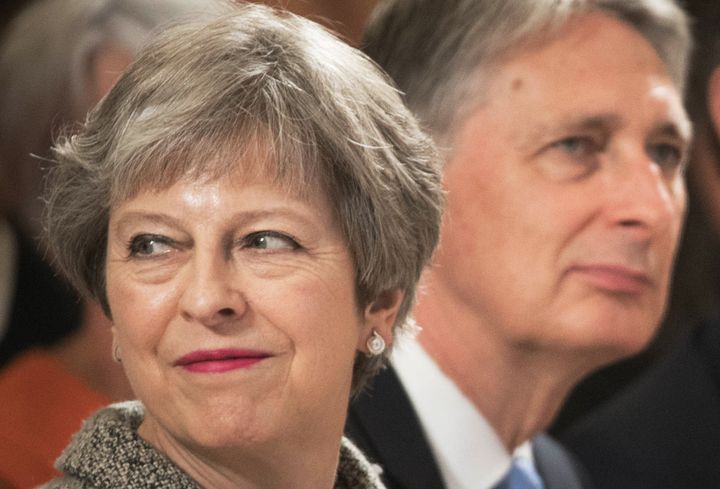
The UK will be worse off with whatever Brexit deal Theresa May gets through parliament, new analysis by the government has claimed.
Withdrawing from the EU under a deal similar to the one the prime minister is trying to get through parliament could shrink the economy by up to 3.9% over the next 15 years, would amount to around £100bn-a-year by the 2030s.
Exiting the bloc with a Canada-style free trade agreement, meanwhile, would cut GDP by 6.7% – and crashing out without a deal would mean a 9.3% hit to the economy.
Brexiteers are likely to trash the document, however, which predicts there will be a minuscule benefit from new trade deals – between just 0.1% of GDP and 0.2%.
The economic model also forecasts higher levels of borrowing, again with all Brexit scenarios likely to push the UK further into the red.
A no-deal scenario could see borrowing climb by an extra £95.1bn, while under a Canada-style deal the figure would be £72bn.
A Norway-style EEA arrangement £22.5bn and under May’s deal additional in-year borrowing would sit at £1.3bn.
Compiled by the Department for Exiting The EU, the Department for Business and the Treasury, the cross-government assessment paints a bleak picture of Britain’s long-term prospects outside of the EU.
SNAP ANALYSIS
By Paul Waugh, Political Editor, HuffPost UK
So, is this Project Fear or Project Reality? Well, based on the huge uncertainty that lies behind the figures published today, it looks like Project Fudge.
Brexiteers and Remainers will each pick the bits of the government’s analysis that support their case, and so too will Theresa May.
But nowhere in the analysis is any pounds-and-pence estimate of the impact on our economy (the £100bn blow to the UK is a journalists’ guesstimate of the PM’s plans). Instead, we just get percentages, always a worrying sign in any financial document.
What the analysis lays bare is that the PM’s Brexit plan is in fact still not a plan in any normal sense. It’s a range of vaguely-worded options as set out in the “political declaration” with the EU.
No.10 stressed this was “an analysis, not a forecast”, a line that sounds like a wilful attempt to get MPs to ignore it. Ahead of her “meaningful vote”, much of this analysis is so opaque as to be meaningless. What would be much more valuable would be a verdict by the Office for Budget Responsibility, the independent watchdog,
Still, there are some stats in the document that stand out. One of the most damaging for Brexiteers is that independent non-EU trade deals will add just 0.2% of our GDP. There’s also the finding that a total clampdown on EU migration will spark the worst case version of May’s own divorce proposal, resulting in a 3.9% hit to the economy.
One big difficulty for the Tories is the risk from all this to their traditional reputation for “sound money”. The document found that even under May’s plans borrowing would soar by £26bn, and under no-deal it would rise by £119bn. And don’t forget this is just the long term analysis. The Bank of England’s short-term verdict due later could be even more worrying.
The PM tried to spin the figures by saying they showed we would be better off “than we are today”, because the economy will keep growing. Yet on her own figures, the economy won’t grow as fast as it would have by remaining in the EU. Her own Chancellor’s candour – admitting we would indeed be poorer, albeit ‘slightly’ poorer – was more telling. It’s up to MPs to now work out whether that ‘slight’ cost is a price worth paying.
The analysis came as Chancellor Philip Hammond admitted that “looking purely at the economics, remaining in the single market would give us an economic advantage” and that “15 years out the economy will be very slightly smaller as a result of the PM’s proposed deal than it would have been if we remained in the European Union”.
He told the BBC Radio 4 Today programme on Wednesday morning: “All of the other options have disadvantages and we have to look not only at the economy but also the need to heal a fractured nation.
“We will not be successful if we remain fundamentally divided and fractured on this issue.”
The government analysis does not attempt to forecast the impact of May’s deal itself.
But it compares the likely impact of the proposals agreed by the cabinet at Chequers in July with the alternative scenarios of Norway-style membership of the European Economic Area, a Canada-style free trade agreement with the EU and a no-deal Brexit.
It finds that GDP will be lower in 15 years under all Brexit scenarios than it would be with EU membership. And in all cases, national income will be reduced if migration from Europe is reduced from its current levels.
The lowest possible hit was a 0.6% reduction to GDP if a deal similar to the current one pushed by May is accompanied by frictionless trade.
The scenario which most closely reflects the government’s plan, however, would see the Chequers deal tempered by some trade friction and with zero net immigration from the EEA.
Under these conditions, GDP could be expected to be 3.9% lower 15 years after Brexit than it would have been if the UK remained. If frictionless trade was achieved, the cut would be around 2.5%.
The North East, North West, Northern Ireland and West Midlands would be hardest-hit by a no-deal Brexit or a Canada-style FTA, while the pain would be more evenly spread under the scenario closest to Mrs May’s deal, with London worst hit.
Meanwhile, speaker John Bercow granted Labour an urgent question in the Commons on the analysis at 12.45pm.